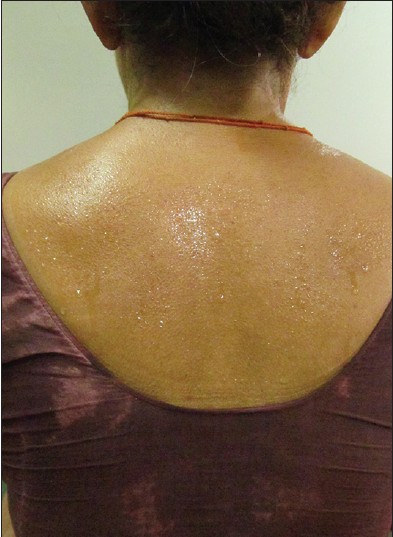Translate this page into:
A curious case of hourly attacks of disabling episodic spontaneous hypothermia with hyperhidrosis
Correspondence Address:
Sharad Mehta
Department of DVL, R.N.T. Medical College, Udaipur, 8A, Tulsinagar, Near Sai Baba Temple, Hiranmagri, Sector 5, Udaipur, Rajasthan
India
| How to cite this article: Mehta S, Ralot T, Masatkar V, Agarwal N, Rana A. A curious case of hourly attacks of disabling episodic spontaneous hypothermia with hyperhidrosis. Indian J Dermatol Venereol Leprol 2015;81:185-186 |
Sir,
A 55-year-old female patient presented with complaints of episodic generalized sweating for the past 8 years. These episodes consisted of 5-10 min of disabling hyperhidrosis occurring at a fixed interval of 1 h, 24 times a day [Figure - 1]. Each episode was preceded by a characteristic aura of epigastric discomfort. There was no history of any confusion, abnormal behavior or movements, seizures, flushing, palpitations, dizziness, or any other physical symptoms during the episode. There was no seasonal or diurnal variation and the episodes persisted even during bathing and sleeping. The only relieving factor was any febrile illness. There was no history of shivering, chills, or rigors during or after the episode. There was no past history of head trauma or spinal injuries. Family history and treatment history were not contributory.
 |
| Figure 1: Profuse hyperhidrosis over back |
The patient was admitted in Department of Neurology, Maharana Bhupal Government Hospital, Udaipur for a period of 15 days, during which we observed hourly episodes of hyperhidrosis, and subsequent hypothermia. The episodes were not associated with any changes in sympathetic activity [Table - 1].

General physical examination was unremarkable. Routine hematological and biochemical investigations were normal. Human immunodeficiency virus (HIV) serology was nonreactive. Hormonal profile, electrocardiogram, X-ray chest, and magnetic resonance imaging (MRI) brain did not reveal any abnormality. There were diffuse cerebral dysrrythmias during the hyperventilation phase of electroencephalogram (EEG).
A provisional diagnosis of episodic spontaneous hypothermia with hyperhidrosis (ESHH) was made. Propranolol and various antiepileptic drugs including phenytoin, carbamazepine, and sodium valproate were tried, without any response. There was transient improvement with cyproheptadine and clonidine, which was followed by relapse.
Episodic spontaneous hypothermia with hyperhidrosis is described as spontaneous episodes of hyperhidrosis associated with hypothermia in the absence of shivering. Various endocrine, autonomic, electrolyte and sleep disturbances have been postulated, but the cause remains obscure. The first clinical case was described by Hines and Bannick in 1934 in a patient suffering from intermittent attacks of sweating followed by chills and subnormal temperature for 10 years. [1] The episodes occurred during a 4- to 6-week period each year at 2 hourly intervals. In 1969, Shapiro et al. described the first two cases of spontaneous periodic hypothermia with hyperhidrosis associated with agenesis of corpus callosum. [2] Reverse Shapiro syndrome, characterized by periodic hyperthermia instead of hypothermia was also found to be associated with agenesis of corpus callosum. [3] Rodrigues et al. found a consistent abnormality in cerebral neurotransmitter levels in patients with spontaneous periodic hypothermia without corpus callosum agenesis. [4] Recently, Tambasco et al. highlighted that among all the cases reported in literature, agenesis of corpus callosum was seen in only 40% of cases. [5]
Spontaneous endogenous hypermelatoninemia has been postulated as a cause in a patient who responded to propranolol. [6] But, in our case, no response was noted with propranolol. Some investigators have described this condition as a manifestation of "diencephalic epilepsy" and reported responses to antiepileptic medications. [7] However, direct evidence for the same has not been found in any case till date to the best of our knowledge.
The aura of epigastric discomfort, fixed interval between episodes and electroencephalogram (EEG) findings seen in our patient support an epileptiform origin of this condition. However, the unresponsiveness to antiepileptic medications and response with cyproheptadine and clonidine indicates the possibility of some other associated pathomechanisms.
The episodes of hypothermia in our patient occurred hourly, 24 times a day, with no diurnal or seasonal variation, for the past 8 years. Most previously reported cases suffered from episodes once in a few days. This case is being reported because of its peculiar severely disabling manifestation and evidence of epileptiform activity, which may be helpful in understanding the pathophysiology of the condition.
| 1. |
EA Hines, EG Bannick. Intermittent hypothermia with disabling hyperhidrosis report of a case with successful treatment. Mayo Clin Proc 1934;9:705.
[Google Scholar]
|
| 2. |
Shapiro WR, Williams GH, Plum F. Spontaneous recurrent hypothermia accompanying agenesis of the corpus callosum. Brain 1969;92:423-36.
[Google Scholar]
|
| 3. |
Hirayama K, Hoshino Y, Kumashiro H, Yamamoto T. Reverse Shapiro's syndrome. A case of agenesis of corpus callosum associated with periodic hyperthermia. Arch Neurol 1994;51:494-6.
[Google Scholar]
|
| 4. |
Rodrigues MM, Lin J, Arita JH, De Castro Neto EF, Scerni DA, Cavalheiro EA, et al. Spontaneous periodic hypothermia and hyperhidrosis: A possibly novel cerebral neurotransmitter disorder. Dev Med Child Neurol 2011;53:378-80.
[Google Scholar]
|
| 5. |
Tambasco N, Belcastro V, Prontera P, Nigro P, Donti E, Rossi A, et al. Shapiro's syndrome: Defining the clinical spectrum of the spontaneous paroxysmal hypothermia syndrome. Eur J Paediatr Neurol 2014;18:453-7.
[Google Scholar]
|
| 6. |
Duman O, Durmaz E, Akcurin S, Serteser M, Haspolat S. Spontaneous endogenous hypermelatoninemia: A new disease. Horm Res Paediatr 2010;74:444-8.
[Google Scholar]
|
| 7. |
DePlaen JL, Sepulchre D, Bidingija M. Paroxysmal hypertension and spontaneous periodic hypothermia. Acta Clin Belg 1992;47:401-7.
[Google Scholar]
|
Fulltext Views
3,589
PDF downloads
1,539





